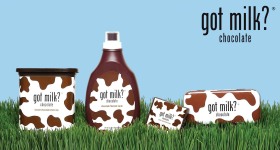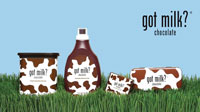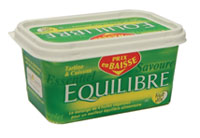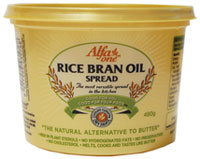

Stonyfield Farm’s YoCalcium yogurt claimed to contain more than twice the calcium of other leading yogurts, plus vitamin D and inulin to boost calcium absorption.
Amid this growing market, Horizon Organic introduced the first DHA-fortified organic milk. DHA omega-3 has been shown to play a positive role in children’s brain, eye and heart health, although a growing body of evidence has demonstrated DHA’s benefits to people of all ages.
Of course, not everything can be about health, and a survey of U.S. adults confirms that treats are worth the guilt. A Harris Interactive survey found two-thirds of U.S. adults (67%) believe full-fat ice cream is worth the guilt. It further found that 73% of men and 66% of women would prefer to eat full-fat ice cream, rather than full-fat varieties of other snacks, be they cookies, chips or candy. "In some ways, the findings are surprising, in light of the success of low-fat varieties of decadent ice creams," noted Neal Glaeser, president of a flavor supplier for the ice cream industry. “But, it does suggest that ice cream stands apart as the kind of treat that consumers are simply unwilling to compromise on the pleasure of eating."
The survey found 52% of adults do not believe decadent flavors, such as moose tracks and rocky road, can be low-fat and still have an appealing taste. However, this does fly somewhat in the face of data from the International Dairy Foods Association (IDFA), which shows low-fat ice cream as the fastest-growing ice cream category. Regardless, full-fat ice cream accounts for 63.8% of the frozen dessert market, according to the USDA.
Low Lowdown
Low-fat options also received a blow from U.S. researchers early in the year. Harvard School of Public Health found women who consume low-fat dairy foods “may have a higher risk of infertility than those who treat themselves to full-fat ice cream or cheese.” Women who ate two or more servings of low-fat dairy foods daily had an 85% greater risk of a certain type of infertility than women who ate less than one serving of low-fat dairy food a week.Women who consumed one serving of high-fat dairy food a day were 27% less likely to be infertile than women who avoided full-fat dairy foods. The researchers looked at data from the “Nurses’ Health Study,” an ongoing survey of thousands of women. They chose the records of 18,555 women between 24 and 42 who had tried to become pregnant or who had become pregnant between 1991 and 1999. Dr. Jorge Chavarro of the Harvard School of Public Health noted, “It was a bit of a surprise to us that high-fat dairy foods were positively related to fertility. There is really not a very clear explanation. It is possible that dairy fat or something along with dairy fat…may be affecting ovulation in women." He said more study was needed before conclusions could be drawn.

San Francisco Chocolate Factory made new additions to its ”got milk?” chocolate line of milk chocolates--Chocolate Syrup and an Instant Chocolate Drink Mix.
Brands Across America
Milk saw a number of efforts to capitalize on popular brands, with a notable introduction from Bravo! Brands Inc. Bravo! Dove Dark Chocolate and Milk Chocolate milks were being produced under a five-year license agreement with Masterfoods USA and distributed through the Coca-Cola Enterprises network.Bravo! Brands Inc. took the opportunity to create new types of dairy products in 2007, with its introduction of the first national launch of milk-based energy and sports drinks. Slammers Sport Milk was described as the first milk-based sports drink, when it debuted over the summer. The company said it was developed “in response to a growing body of scientific and empirical evidence that suggests milk can play an important role in post-exercise recovery and rehydration when used as a replenishment delivery system.” Claiming the same rehydration capabilities as leading sports drinks, Slammers Sport Milk also contained CoQ10 and a vitamin B complex to “provide fast and long-lasting energy.” Roy Warren, Bravo! Brands’ CEO, noted, “Product development began soon after we learned about the Indiana University study, which revealed that chocolate milk’s carb-to-protein ratio was well-suited to recharge muscles worn-out from exercise.” That study was published in the February 2006 issue ofInternational Journal of Sport Nutrition and Exercise.
At the same time, Bravo! announced testing had begun on Slammers Energy Milk, featuring “the goodness of milk in a beverage that provides twice the energy of the leading energy drink.” Vanilla, coffee and chocolate were the flavors in development at the time. Both of the Slammers’ products were produced aseptically, needed no refrigeration before opening and had a shelflife of up to eight months.
Dairy also took a functional route in a launch from Dreamerz Foods. Dreamerz was a creamy, milk-based beverage featuring active ingredients clinically proven to help promote sleep, reduce stress and promote relaxation. Its flavors included Chocolate S’nores (a milk chocolate variety), Vanilla van Winkle (French vanilla) and Creme de la REM (dark chocolate mint). All-natural, low in fat and a good source of calcium, the range also met another key trend noticed in recent years: it had 100 calories per serving.
While tea received positive health news in recent studies, research suggested milk could eliminate its cardiovascular benefits.The European Heart Journalshowed that black tea “significantly” improves the ability of the arteries to relax and expand, but the addition of milk blunted the effect. Researchers found casein interacted with the tea to decrease the concentration of catechins in the beverage.

In the Business
The dairy category had a fair share of acquisition news this year as well, with Saputo being a particularly active company. Early in 2007, Land O’Lakes announced an agreement for the sale of its Cheese & Protein International (CPI) operations to Saputo for a sale price of approximately $216 million, including a long-term milk supply agreement under which Land O’Lakes would be the full milk supplier to the CPI facility.Dreyer’s also made a significant purchase early in the year with its acquisition of Eskimo Pie and Chipwich Brands and Real Fruit trademark. The purchase price was just under $19 million, plus the assumption of related liabilities of an estimated $1 million.
The U.S. dairy market was set to get a little more competition, as earlier in the year, Swiss dairy group Emmi announced plans to expand in the U.S. over the course of the year, all part of the company’s ongoing international expansion plan in fresh dairy. Its 2006 sales increased 15%, boosted by health and wellness issues.

Anniversary Annals
A chocolate confection celebrating its 100th anniversary also made headlines on the dairy aisles, as MaggieMoo’s International introduced super-premium ice cream treats (including cakes and cupcakes) made with Hershey’s Kisses Chocolates and Kissables candies. The products included a Truffle cake featuring Kisses, strawberry ice cream and rich chocolate ganache icing, as well as Tree House Fresh Escape, an ice cream creation with Twizzler’s ice cream, Kissables, brownies and marshmallow cream.As if the ice cream itself were not enough to tempt consumers, Dreyer’s sought to increase its ice cream’s appeal to fans of the television programAmerican Idol. Dreyer’s Slow Churned launched its firstAmerican Idolflavors: Choc ‘N Roll Caramel, Hollywood Cheesecake, Soulful Sundae Cone, Triple Talent and Take the Cake. The offerings were only around for a limited time; however, as a fan vote at slowchurned.com selected one to earn a permanent spot in the Slow Churned line.
Dairy and Health
The well-publicized benefits of the Mediterranean diet began to make their way into the dairy aisles, with Unilever’s extension of the I Can’t Believe It’s Not Butter line. The Mediterranean Blend variety was made with olive oil and promised to be an excellent source of omega-3, naturally cholesterol-free and free of trans fat. A light version also had 50% less fat and calories than butter.Within the butter segment, however, the natural/organic trend remained strong. Dairy Farmers of America launched a new natural butter under the Cache Valley brand. Meanwhile, Kate’s Homemade Butter (from the company of the same name) promised no additives or preservatives, and it made sure to note the product was made from fresh cream gathered from farms that do not treat their cows with artificial growth hormones, notably rBGH and rBST. (The former was likewise absent from Cady Creek Farms’ Wisconsin Organic Sliced Gold’n Jack Semi Soft Cheese, which was also USDA organic-certified.)
While it might be anathema to fans of organics, products from cloned animals received quite a bit of notoriety in 2007. Dean Foods Co., for example, announced it would not purchase milk from cloned cows, a move that could have serious consequences for the commercial viability of such products in the country. “All the studies that have been done with consumers show that they are not in favor of it,” said Amy Barker, a Dean spokesperson. “So it's in response to the needs and preferences of our consumers.”
Dean’s announcement followed the FDA’s late-December assessment stating that meat and milk from clones of adult cattle, hogs and goats and their offspring were “as safe to eat as food from conventionally bred animals.” The agency has not yet written a final policy statement, which is expected by late spring.
Buttering Them Up
One interesting butter introduction, though, managed to add flavor. Odell’s Seafood Butter, under the company’s Chef’s Butter brand, was free of trans fat. Odell’s notes the product is “designed to add a rich, natural butter flavor to all cooked and fresh seafood.” Described as ideal for dipping lobster, crab and many other types of fresh seafood, it is said to be the same type of dipping butter as is found in restaurants.Another unique offering in the category came courtesy of Galaxy Nutritional Food. Its Rice Grated Topping has a parmesan flavor but is free from cholesterol, lactose, gluten, soy, preservatives and trans fat.
A release from Sorrento Lactalis represented a small trend, that of functional cheese. Mozzarella String Cheese was high in calcium and vitamin D and promised a better absorption of calcium to build strong bones and muscles.
With the positive health attributes that are strongly tied to dairy products, it is no surprise that many of the category’s introductions are geared to children.
Yoplait launched a yogurt drink under the Yoplait Kids brand. Available in a strawberry and banana flavor, it was formulated with DHA for brain growth and development, while also serving as a good source of calcium and vitamins A and D. The same company also introduced a carbonated yogurt, the first launch resulting from General Mills’ Worldwide Innovation Network effort mentioned in the January issue ofPrepared Foods. A collaboration with developers at Brigham Young University, Yoplait Go-Gurt Fizzix Fizzy Yogurt Snack contained vitamins A and D, the same nutrition of the regular Go-Gurt, and such flavors as Triple Berry Fusion/Fruit Punch Charge, Blue Raspberry Rage/Strawberry Watermelon Rush and Wild Cherry Zing/Strawberry Lemonade Jolt varieties.
More function could be found in a smoothie range containingbifidobacterium(to help support the immune system) under the Kroger Active Lifestyle brand. Danone’s Danino children’s drinking yogurt in Canada added DHA omega-3 from fish oil, while Inter-American Products’ Active Lifestyle Milk contained plant sterols (found to help cut the risk of heart disease) and vitamins A and D.
Dannon announced plans to increase its yogurt sales in the coming year by expanding its lighter offerings. It will launch a fruit-enhanced Light & Fit extension to be called Light & Fit 0% Plus, while DanActive Light will be a new version of DanActive with less than half the calories. The company’s “high-health” strategy aims to provide consumers with yogurt that has benefits beyond basic nutrition, a la previous introductions like probiotic Activia (two years ago), DanActive and Dannon Activia Light (both released last year). Andreas Ostermayr, the company’s chief marketing officer, states, “Our strategy focuses on the absence of negatives, in terms of calories, and the presence of positives; that is, the addition of nutrients and vitamins in diets.”
The Light & Fit 0% Plus seeks to add nutrients, rather than reduce calories. The seven-SKU line has around 60 calories per 4oz cup and is sweetened with a proprietary blend of sweeteners, which includes acesulfame potassium, aspartame, fructose and sucralose. For the 52 weeks through November of 2007, Activia had grown 48%, to reach $181.3 million in sales, Information Resources Inc. (IRI) reports. Over the same period, DanActive grew 185% to reach $60 million, while Dannon Activia Light’s sales increased 197.5% to hit $57 million.
Dannon’s products may have featured the term “active” prominently, but it did not have a monopoly on the term. The LiveActive Movement was an effort to help consumers with digestive health problems to choose foods that promote gut health. Kraft Foods’ LiveActive was a line of products specifically designed to help this need. The line included LiveActive Cottage Cheese from Breakstone’s/Knudsen and LiveActive Natural Cheese Snacks from Kraft.
Much of the information in this article was derived from the Mintel Global New Products Database, www.gnpd.com, 312-932-0400. Special thanks also goes to sister publication Dairy Foods magazine.
Going Global
In China, Sanjiu Healthcare launched Sanjiu Soybean Milk Powder, targeting middle-aged and elderly consumers. It was rich in calcium, lecithin and protein to provide the user with a healthy balance of nutrients.In France, Unilever introduced Fruit D’or Equilibre, a low-fat margarine for spreading and cooking. Derived from a combination of four different vegetable oils (sunflower, rapeseed, copra and palm oils), it also was enriched with vitamin e and other nutrients, which the company claimed would provide a better dietary balance.
Black Sesame has traditionally been used to create Black Sesame Soup, a Chinese dessert. This year, however, it appeared in Longdan Black Sesame Milk from China’s Heilongiiang Longdan Dairy. The company noted the milk was rich in protein, calcium and vitamin c.
In New Zealand, Old Fashioned Foods launched Alfa One 100% Pure Rice Bran Oil. The spread was a natural alternative to butter and contained no hydrogenated fats, cholesterol, or animal or vegetable fats--just rice bran oil and natural ingredients. It also featured the plant sterol oryzanol to help the body reduce cholesterol absorption.
To appeal to the on-the-go u.k. consumer, Innocent introduced Innocent Breakfast Smoothie. The “breakfast thickie” blended yogurt, oats, raspberries and blueberries, while also containing calcium, probiotic cultures and no preservatives.
Nipponluna in Japan introduced Sugarless Nighttime Yogurt. Created to alleviate hunger during the night, it had 50% less calories than traditional yogurt, while also featuring 500mg of collagen to maintain good skin and 50mg of relaxation-inducing theanine to aid sleeping. A functional butter in France from Elvir, meanwhile, added omega-3 fatty acids: Elle & Vire Omega 3 Beurre Léger Demi-Sel was a half-salted, light butter with 41% fat and guaranteed levels of vitamins A and E.
PHOTOS COURTESY OF MINTEL GNPD
